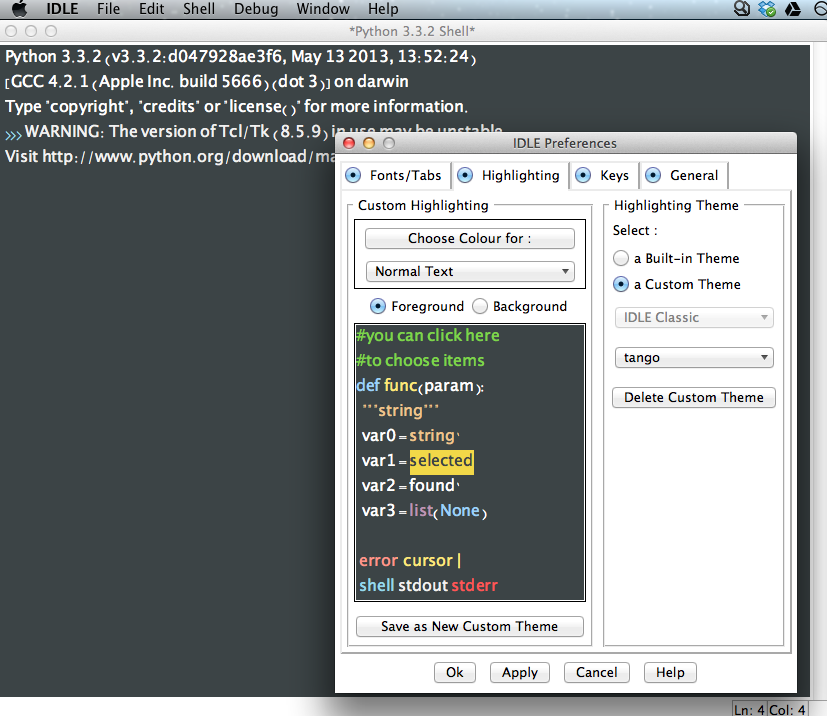
- HOW TO RESET PYTHON ON MAC HOW TO
- HOW TO RESET PYTHON ON MAC MANUAL
- HOW TO RESET PYTHON ON MAC CODE
- HOW TO RESET PYTHON ON MAC MAC
I am struggling on where to put this while loop in my code. I don’t like this and would really like Program B to pick up the change and restart itself only if there has been a change. So I set up a cron job that just reboots the PI every night. Until know I couldn’t get program A to restart program B.
HOW TO RESET PYTHON ON MAC CODE
If I have, it downloads the code and overwrites my program B code. I have a cron job that runs (lets call it program A) every night at midnight and goes to a webservice and checks to see if i have updated my code to my program (lets call it program B).

I am very new to Python though so I am struggling figuring out how exactly to implement this. This looks to be exactly what I am looking for. The complete source code for this post is available on GitHub. If you know of another way of restarting a Python program within itself, please share it by posting a comment. Moreover, there exist other methods of checking whether a watched file has changed and acting upon such a change. Depending on the actual situation, other approaches, like killing the script externally and starting it afterwards, may be more suitable for you. Of course, the presented solution is only one of the possible ways of restarting a Python script. Therefore, if you have any opened files at the time of restarting the script, you should flush them using f.flush() or os.fsync(fd) before calling an exec*() function. If you use the solution above, please bear in mind that the exec*() functions cause the current process to be replaced immediately, without flushing opened file objects. Instead, it starts executing the current script from its beginning, which is what we want. The _file_ variable holds a path to the script, sys.argv are arguments that were passed to the script, and sys.executable is a path to the Python executable that was used to run the script. To explain, the arguments of os.execv() are the program to replace the current process with and arguments to this program. Os.execv(sys.executable, + sys.argv)Įither way, do not forget to import the sys module: In such a situation, to restart the script, use the following code:
HOW TO RESET PYTHON ON MAC MAC
For example, on Linux or Mac OS, you can make the file executable by putting the following line to the top of the file The exact version and arguments depend on how you run the script. We restart the script by utilizing one of the exec*() functions from the os module.

If either of the files that we watch has changed, we restart the script. Then, we add a check if any of these files have changed into the main loop: When the script starts, we get and store the time of the last modification of these files by using os.path.getmtime(): We watch the global configuration file, the local configuration file, and the script itself, whose path can be obtained from the special global variable _file_. Checking Watched Files For Changesįirst, we define the paths to the files whose change we want to watch:
HOW TO RESET PYTHON ON MAC HOW TO
After that, we show how to restart the script. Next, we describe how to watch files for changes. After that, the script waits for inputs and processes them in an infinite loop. That is, it processes the arguments and loads the configuration from the configuration files. # Parse the arguments and configuration files. In the rest of this post, we will show such a way.įor the purpose of the present post, let us assume that the script has the following structure: It would be nice if there existed a way of restarting the script within itself after it detected that its sources or a configuration file changed. Otherwise, someone may exploit the vulnerability if you did not restart the script.

When you fix a vulnerability in the script, you want to be sure that you do not forget to restart the script.
HOW TO RESET PYTHON ON MAC MANUAL
However, this requires manual intervention, which you may forget to do. One way of doing so is to kill the script and run it again. For example, if you fix a bug in it or change its configuration. For example, a web server may react to a request for a page, which results into sending a response to the user.įrom time to time, it may be necessary to restart the script. In this loop, it waits for inputs from the environment and acts upon them. When the script starts, it reads its configuration from a file, and then enters an infinite loop. Examples may be a web server, a logging service, and a system monitor. You have a Python script that runs as a daemon and regularly performs the prescribed tasks. In this post, you will see a way of doing this in Python.Ĭonsider the following scenario. Sometimes, you may wish to check within a script when a configuration file or the script itself changes, and if so, then automatically restart the script.


 0 kommentar(er)
0 kommentar(er)
